UH’S PHONE SURVEY POLLEES WANT TO MAKE FLOOD RECORD A GIVEN IN HOME SALES 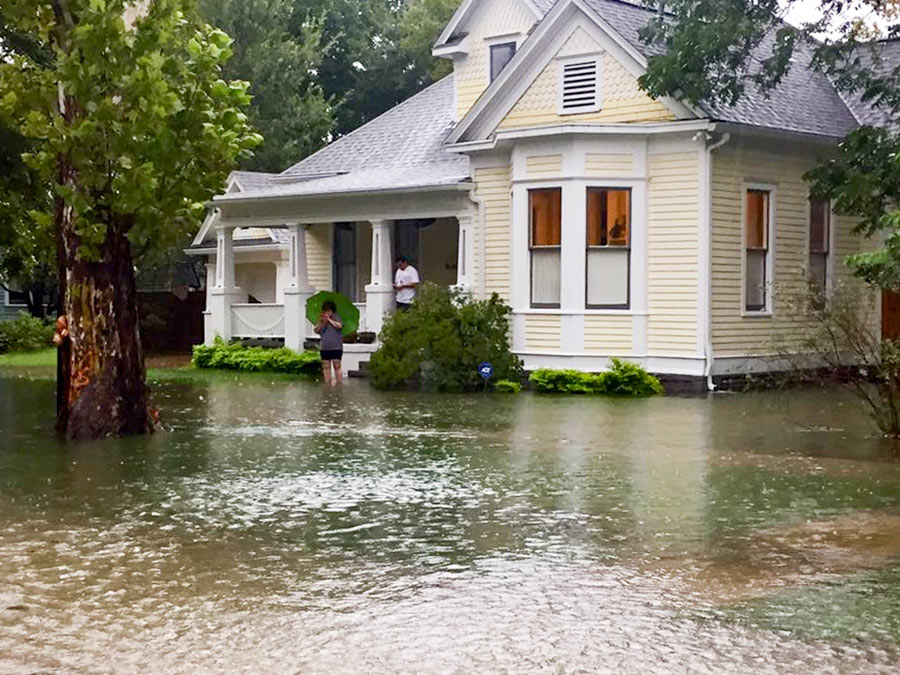 Here’s a tidbit from the UH Hobby School of Public Affairs’ new post-Harvey telephone questionnaire: 90 percent of Harris, Fort Bend, Brazoria, and Montgomery County residents who responded think sellers should be required to disclose prior flood damage to their homes and prior flooding in the surrounding neighborhood. Aren’t sellers already obligated to reveal their homes’ flood histories? Well, almost. State law requires most sellers to spill the details — but only if their home was previously occupied (and not if it was foreclosed on or if they’re selling it to execute someone’s will). For developers selling newly-built homes — sometimes in entirely new subdivisions — the rules are foggier: not all surrounding flood designations need to be disclosed to buyers. Among those details that can be withheld: whether the home is located in a flood pool, an area of land prone to inundation when water builds up behind a reservoir dam like that of the Addicks and Barker, as Lise Olsen wrote in the Chronicle last year. [University of Houston Hobby School of Public Affairs] Photo of home at 8th St. and Arlington during Harvey: Swamplot inbox
Here’s a tidbit from the UH Hobby School of Public Affairs’ new post-Harvey telephone questionnaire: 90 percent of Harris, Fort Bend, Brazoria, and Montgomery County residents who responded think sellers should be required to disclose prior flood damage to their homes and prior flooding in the surrounding neighborhood. Aren’t sellers already obligated to reveal their homes’ flood histories? Well, almost. State law requires most sellers to spill the details — but only if their home was previously occupied (and not if it was foreclosed on or if they’re selling it to execute someone’s will). For developers selling newly-built homes — sometimes in entirely new subdivisions — the rules are foggier: not all surrounding flood designations need to be disclosed to buyers. Among those details that can be withheld: whether the home is located in a flood pool, an area of land prone to inundation when water builds up behind a reservoir dam like that of the Addicks and Barker, as Lise Olsen wrote in the Chronicle last year. [University of Houston Hobby School of Public Affairs] Photo of home at 8th St. and Arlington during Harvey: Swamplot inbox
Tag: Flooding
COMMENT OF THE DAY: THOSE LITTLE EXTRAS THAT MAKE ALL THE DIFFERENCE  “Compared to the price of raising the house, also adding a spare rowboat in the garage is very, very cheap.” [diggity, commenting on Comment of the Day: Still Stranded] Illustration: Lulu
“Compared to the price of raising the house, also adding a spare rowboat in the garage is very, very cheap.” [diggity, commenting on Comment of the Day: Still Stranded] Illustration: Lulu
COMMENT OF THE DAY: STILL STRANDED 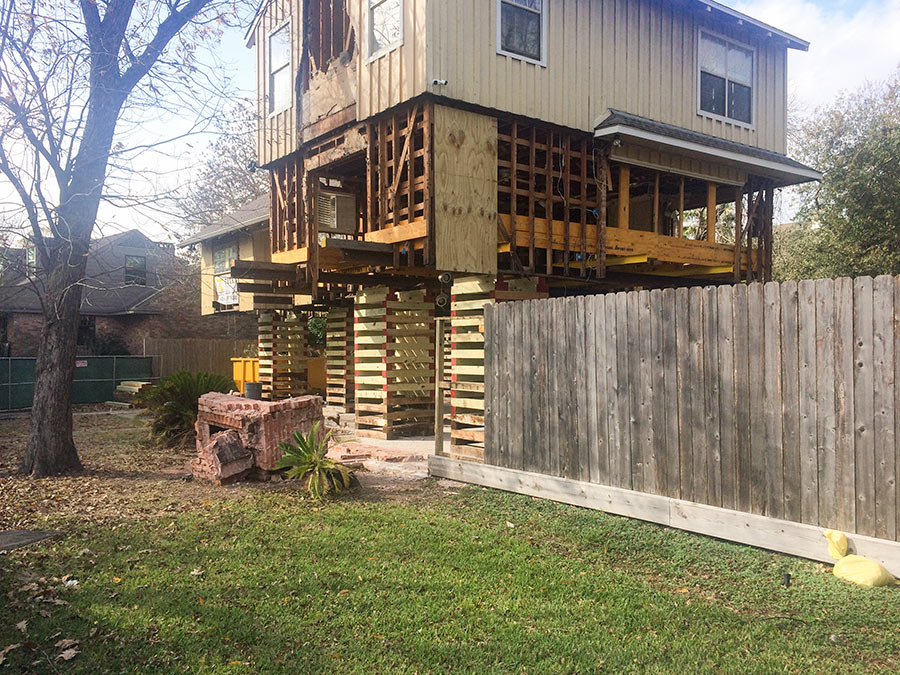 “My first thought is that raising a home might protect the physical property, but it doesn’t remove it from the path of floodwaters. A flooding event could still strand a family, potentially putting them in a life-threatening situation from which others would have to rescue them. Tax roll aside, is this the right thing to do?” [Nice Neighbor, commenting on Comment of the Day: Why It Pays To Raise Those Flooded Meyerland Homes] Photo: Christine Gerbode
“My first thought is that raising a home might protect the physical property, but it doesn’t remove it from the path of floodwaters. A flooding event could still strand a family, potentially putting them in a life-threatening situation from which others would have to rescue them. Tax roll aside, is this the right thing to do?” [Nice Neighbor, commenting on Comment of the Day: Why It Pays To Raise Those Flooded Meyerland Homes] Photo: Christine Gerbode
WHAT HOUSTON WILL SPEND TO RAISE A FEW FLOODY HOUSES IN MEYERLAND 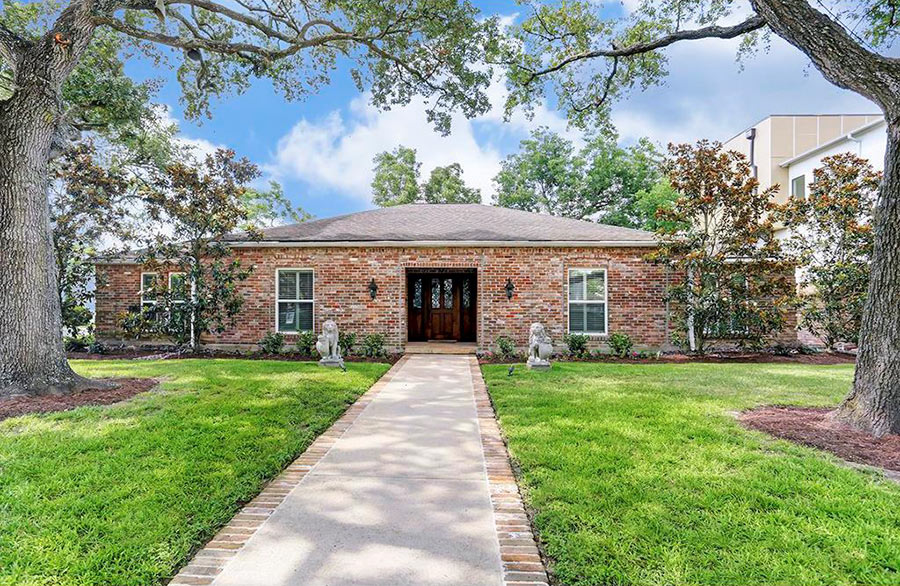 Houston City Council approved construction yesterday to raise 5 Meyerland houses — a subset of the 42 Houston homes FEMA paid the city $14.8 million to elevate back in 2015. One of those 42 houses has already been jacked up and 8 more are currently within the levitation process, according to the Chronicle’s Rebecca Elliott and John D. Harden. The costs to raise the 5 homes now slated for elevation 12 ft. above flood level — which include a few extra thousand dollars to put residents up in temporary lodging — range from $218,700 to $416,000 per property. In total, the bill comes to $1.6 million. Harris County appraises the total value of properties themselves from $125,906 to $507,152, with the value of improvements within that ranging from $34,700 to $201,200. One of the houses — 5150 Braesheather Dr. — shown above as it appeared before Harvey, is currently listed for sale. [Houston Chronicle; more info (items 24–28)] Photo of 5150 Braesheather Dr.: HAR
Houston City Council approved construction yesterday to raise 5 Meyerland houses — a subset of the 42 Houston homes FEMA paid the city $14.8 million to elevate back in 2015. One of those 42 houses has already been jacked up and 8 more are currently within the levitation process, according to the Chronicle’s Rebecca Elliott and John D. Harden. The costs to raise the 5 homes now slated for elevation 12 ft. above flood level — which include a few extra thousand dollars to put residents up in temporary lodging — range from $218,700 to $416,000 per property. In total, the bill comes to $1.6 million. Harris County appraises the total value of properties themselves from $125,906 to $507,152, with the value of improvements within that ranging from $34,700 to $201,200. One of the houses — 5150 Braesheather Dr. — shown above as it appeared before Harvey, is currently listed for sale. [Houston Chronicle; more info (items 24–28)] Photo of 5150 Braesheather Dr.: HAR
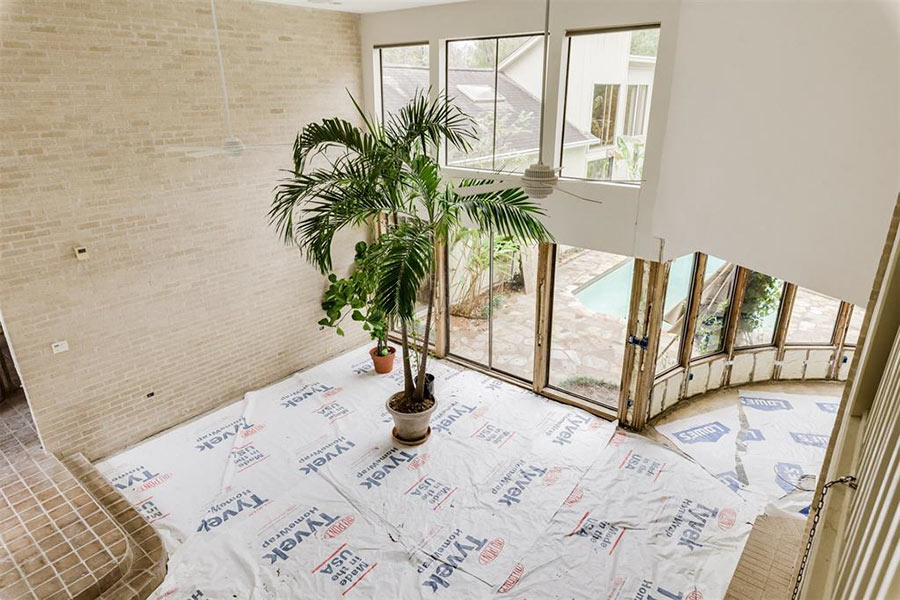
- 826 Plainwood Dr. [HAR]
A FLOOD OF CHRISTMAS DINERS AT VIETOPIA An impromptu performance surrounding a centerpiece aquarium greeted Christmas dinner diners at Vietopia yesterday. Loud screams accompanied the appearance of twin streams springing from a leak in the glass on the dining side of freestanding structure at the Vietnamese restaurant in the Plaza in the Park (better known as the Kroger shopping center just south of the Southwest Fwy. on Buffalo Spdwy.) As a steady fountain of fishwater aimed itself at a nearby table or 2, the restaurant’s staff sprung into action: Large plastic garbage cans were deployed quickly to catch the water, and waiters used nets to collect the fish and transport them to new homes. [Wendy G Young Lightwalker, via abc13] Video: Wendy G Young LightWalker
WHAT IT TAKES TO JACK A HOUSE 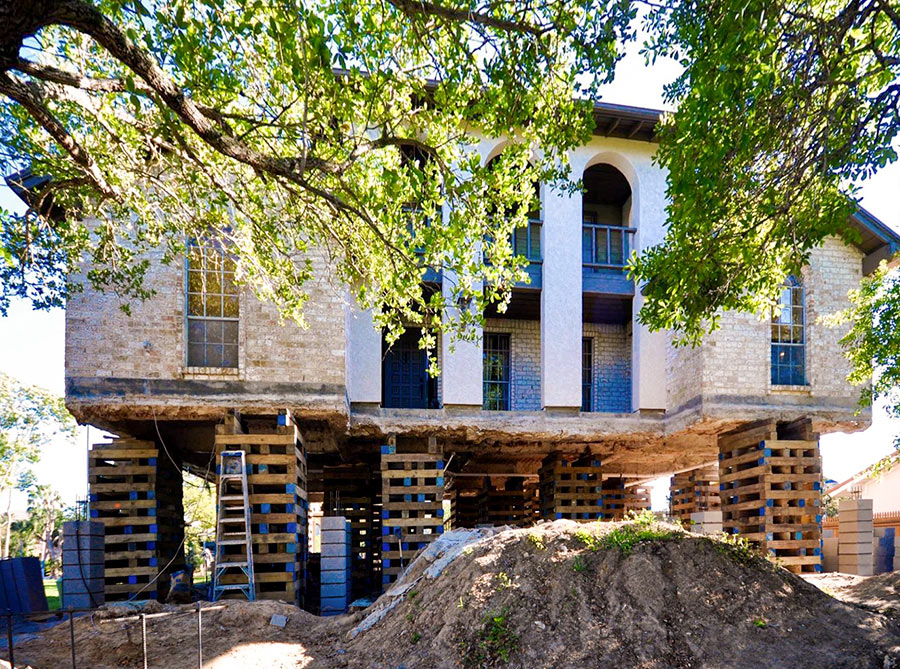 “Adam Bakir, a Houston builder and remodeler, does one or two home elevations a year. The job is akin to major surgery. Workers tunnel under the house, Bakir said, then raise the whole thing on jacks—the slab and the house that rests on it. Since Harvey, Bakir has received more than 20 inquiries about home elevation. If potential customers ask for a cost estimate, he’ll tell them: between about $75 and $100 per square foot. ‘If you have a 2,500-square-foot house, which is typical,’ he said, ‘the upper end of it would be about $250,000. The lower end, around $180,000.‘” [CityLab] Photo: Arkitektura Development
“Adam Bakir, a Houston builder and remodeler, does one or two home elevations a year. The job is akin to major surgery. Workers tunnel under the house, Bakir said, then raise the whole thing on jacks—the slab and the house that rests on it. Since Harvey, Bakir has received more than 20 inquiries about home elevation. If potential customers ask for a cost estimate, he’ll tell them: between about $75 and $100 per square foot. ‘If you have a 2,500-square-foot house, which is typical,’ he said, ‘the upper end of it would be about $250,000. The lower end, around $180,000.‘” [CityLab] Photo: Arkitektura Development
COMMENT OF THE DAY: THE ONLY MACKIE AND KAMRATH HOMES LEFT ON THE TIEL WAY LOOP 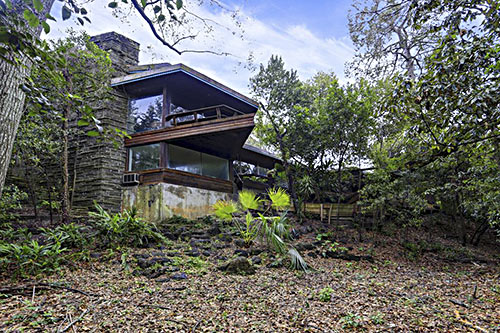 “. . . My husband and I drove around Tiel Way after the storm to check on all the MacKie and Kamraths. There were several homes on the street that flooded — and not just by a few inches but into their second levels. One of the things that make the Kamraths of this era (and really, many high-end midcentury homes) so gorgeous and unique is the abundant use of wood panels for all walls, doors, built-in storage cabinets and seating — everything. But it also makes them particularly expensive and hard to fix after extensive water damage.
As Swamplot reported earlier this year, the home at 2 Tiel Way was bought with the intention to restore but had so much termite and water damage it would have cost double to restore compared to a full rebuild price. So that’s what they are doing: rebuilding the same house. . . . It’s a controversial choice but in my opinion it’s the best architectural conservation alternative to demolition. But not everyone has the resources to undertake something like a full architectural rebuild. So while the demo of this house, one of Kamrath’s finest, is certainly a punch in the gut . . . I get it. They probably would have saved it if they could.
Tiel Way was the last concentration of MacKie and Kamrath’s great residential works, at one point having 7 homes on the loop. After this demolition we will be down to 2.5: the Gold Brick–awarded restoration at 67 Tiel Way (which thankfully, did not appear to have Harvey flooding issues), Kamrath’s own residence at 8 Tiel Way (definitely flooded, but appears to be safe at the moment), and the rebuild currently in progress at 2 Tiel Way.
48 Tiel Way won’t be the only midcentury treasure lost to Harvey, but it’s certainly one of the saddest to see go.” [Rabbit, commenting on Daily Demolition Report: Tiel Repeal; previously on Swamplot] Photo of 48 Tiel Way: HAR
“. . . My husband and I drove around Tiel Way after the storm to check on all the MacKie and Kamraths. There were several homes on the street that flooded — and not just by a few inches but into their second levels. One of the things that make the Kamraths of this era (and really, many high-end midcentury homes) so gorgeous and unique is the abundant use of wood panels for all walls, doors, built-in storage cabinets and seating — everything. But it also makes them particularly expensive and hard to fix after extensive water damage.
As Swamplot reported earlier this year, the home at 2 Tiel Way was bought with the intention to restore but had so much termite and water damage it would have cost double to restore compared to a full rebuild price. So that’s what they are doing: rebuilding the same house. . . . It’s a controversial choice but in my opinion it’s the best architectural conservation alternative to demolition. But not everyone has the resources to undertake something like a full architectural rebuild. So while the demo of this house, one of Kamrath’s finest, is certainly a punch in the gut . . . I get it. They probably would have saved it if they could.
Tiel Way was the last concentration of MacKie and Kamrath’s great residential works, at one point having 7 homes on the loop. After this demolition we will be down to 2.5: the Gold Brick–awarded restoration at 67 Tiel Way (which thankfully, did not appear to have Harvey flooding issues), Kamrath’s own residence at 8 Tiel Way (definitely flooded, but appears to be safe at the moment), and the rebuild currently in progress at 2 Tiel Way.
48 Tiel Way won’t be the only midcentury treasure lost to Harvey, but it’s certainly one of the saddest to see go.” [Rabbit, commenting on Daily Demolition Report: Tiel Repeal; previously on Swamplot] Photo of 48 Tiel Way: HAR
COMMENT OF THE DAY: ANOTHER WILLOW MEADOWS FAREWELL 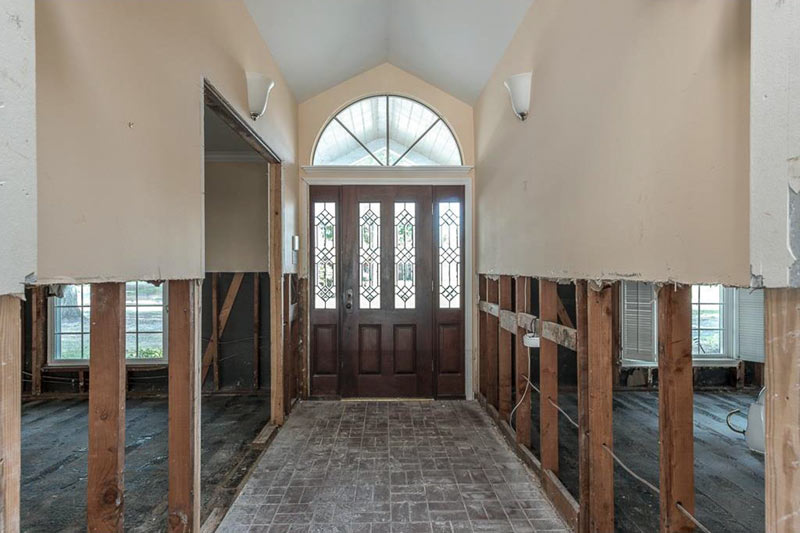 “Willowgrove is a beautiful street, and sadly, I think we’re going to see several homes come down akin to what we saw & are seeing again in Meyerland (I believe there was another one yesterday). It’s predominately 1960s single-story ranch homes, many custom designed and some of them oversized vs. the rest of neighborhood, below a canopy of oaks that drape the street. It’s terribly sad that what it was before is just gone now. Willowgrove backs up to one of the feeder ravines that breached when the bayou did, and homes on both sides of it — Cliffwood and Willowgrove — took a massive hit compared to the surrounding streets that only had street flooding. The cap on flood insurance, if homeowners had it, wouldn’t cover the value of those homes. I’ve had neighbors ask me, and I genuinely do not know — are those concrete ravines/mini-bayous supposed to drain/connect to Willow Water Hole at some point? Was that already supposed to have happened? If so, what was the delay?” [Heather, commenting on Daily Demolition Report: Lynn Parked] Photo of 10202 Willowgrove Dr. interior (now for sale): HAR
“Willowgrove is a beautiful street, and sadly, I think we’re going to see several homes come down akin to what we saw & are seeing again in Meyerland (I believe there was another one yesterday). It’s predominately 1960s single-story ranch homes, many custom designed and some of them oversized vs. the rest of neighborhood, below a canopy of oaks that drape the street. It’s terribly sad that what it was before is just gone now. Willowgrove backs up to one of the feeder ravines that breached when the bayou did, and homes on both sides of it — Cliffwood and Willowgrove — took a massive hit compared to the surrounding streets that only had street flooding. The cap on flood insurance, if homeowners had it, wouldn’t cover the value of those homes. I’ve had neighbors ask me, and I genuinely do not know — are those concrete ravines/mini-bayous supposed to drain/connect to Willow Water Hole at some point? Was that already supposed to have happened? If so, what was the delay?” [Heather, commenting on Daily Demolition Report: Lynn Parked] Photo of 10202 Willowgrove Dr. interior (now for sale): HAR
COMMENT OF THE DAY: SELLING THE HOUSE AT THE END OF THE RAINBOW  “Fabulous lot adorned with critters of all varieties, this property now features wild herrings, cranes, frogs, alligators and migrating herds of antelope during the rainy season. The home was originally built as an ark on pristine gathering grounds for pairs of animals to accumulate during the final days of destruction per sellers disclosure. Tall mature trees on property present amazing opportunity to cultivate your very own white dove habitat for olive branch collection.” [Toby, commenting on Houston Home Listing Photo of the Day: Outdoor Dining Area] Illustration: Lulu
“Fabulous lot adorned with critters of all varieties, this property now features wild herrings, cranes, frogs, alligators and migrating herds of antelope during the rainy season. The home was originally built as an ark on pristine gathering grounds for pairs of animals to accumulate during the final days of destruction per sellers disclosure. Tall mature trees on property present amazing opportunity to cultivate your very own white dove habitat for olive branch collection.” [Toby, commenting on Houston Home Listing Photo of the Day: Outdoor Dining Area] Illustration: Lulu
COMMENT OF THE DAY: WHAT FLOODING ON THE WEST SIDE TOOK AWAY  “Homes underwater for extended periods can be rebuilt, as long as they were not subjected to currents sufficient to cause major structural damage or foundation scour. They just take longer to dry out (ours took over a month).
Like Local Planner said, in many of the flooded neighborhoods north of the bayou, original-condition homes had basically no value before the flood (i.e. they were being sold for lot value and torn down). The process is indeed accelerating, with new builds being elevated à la Bellaire and Meyerland.
The big question mark for me is how much of a market there’ll be for $1+ million new homes in a potentially flood-prone area (even if your elevated home doesn’t flood during the next big one, you’d likely lose the cars in your non-elevated garage and need to be evac’d by boat). The market was soft in the Energy Corridor even before the flood. A new supply of high-end homes doesn’t automatically beget demand. Hopefully the new MD Anderson complex in the area will help (and potentially spur further diversification of employment in the Energy Corridor beyond oil and gas).” [Grant, commenting on Daily Demolition Report: Memorial Glint] Illustration: Lulu
“Homes underwater for extended periods can be rebuilt, as long as they were not subjected to currents sufficient to cause major structural damage or foundation scour. They just take longer to dry out (ours took over a month).
Like Local Planner said, in many of the flooded neighborhoods north of the bayou, original-condition homes had basically no value before the flood (i.e. they were being sold for lot value and torn down). The process is indeed accelerating, with new builds being elevated à la Bellaire and Meyerland.
The big question mark for me is how much of a market there’ll be for $1+ million new homes in a potentially flood-prone area (even if your elevated home doesn’t flood during the next big one, you’d likely lose the cars in your non-elevated garage and need to be evac’d by boat). The market was soft in the Energy Corridor even before the flood. A new supply of high-end homes doesn’t automatically beget demand. Hopefully the new MD Anderson complex in the area will help (and potentially spur further diversification of employment in the Energy Corridor beyond oil and gas).” [Grant, commenting on Daily Demolition Report: Memorial Glint] Illustration: Lulu
The U.S. Chemical Safety Board’s animated video (above) on the explosions at the Arkema Chemical Plant in Crosby recounts the steps taken by the brave workers stuck in charge of the facility in the aftermath of Hurricane Harvey. But a few angles less charitable to the company’s emergency planning effort aren’t included — possibly because they’d be a little more involved to animate. For example, the noxious fumes that emanated from the first fire, on the night of August 31, which according to a lawsuit filed later Arkema gave no warning about — and sent 23 people to the hospital, many of them vomiting and gasping for cleaner air.
And another detail: The remote detonations of 6 trailers containing unrefrigerated organic peroxides were carried out by the Houston Police Department’s bomb squad. “The entire police operation was conducted without warning the public,” write the Houston Chronicle‘s Matt Dempsey and Jacob Carpenter. “Until the documents were released earlier this month by the EPA, the public didn’t know who performed the controlled burn, or how it was done.”
THE KATY ELEMENTARY SCHOOL WITH A FLOOD POOL SECRET 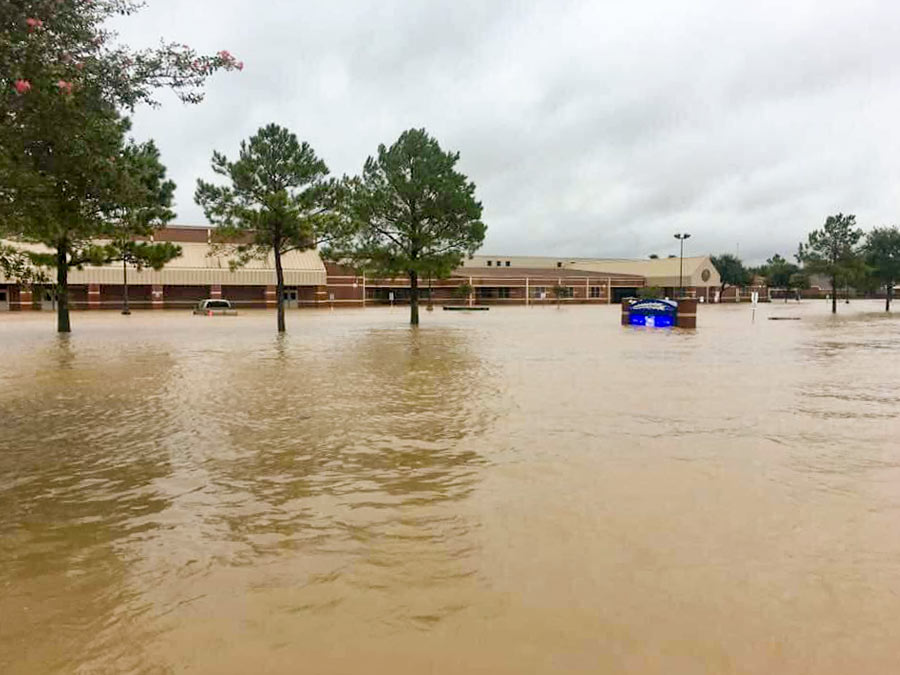 Some documents related to the Katy ISD’s 1998 purchase of the 15-acre site now occupied by Creech Elementary School at 4242 S. Mason Rd. have been frozen — in an attempt to preserve them, after they got flooded when Barker Reservoir got backed up after Hurricane Harvey. What those records might show, once thawed: some explanation for why school officials at the time signed a notice indicating they did not review a map filed with the county by Westbrook Cinco East LP (the developer from whom the property was purchased) that disclosed in a note that the land came with the risk of “extended controlled inundation.” Though several Katy schools sit on land near or in the Barker reservoir flood pool — the area expected to fill up with water when the dam is closed for a major flooding event — only Creech suffered major damage. All 800 Creech students are now attending classes at the University of Houston’s nearby Cinco Ranch campus while the school undergoes an estimated $5 million worth of repairs. The school district’s superintendent tells the Chronicle‘s Lise Olsen that he and other school officials were unaware that the school was built in the flood pool until they were contacted for her story. [Houston Chronicle] Photo of flooding at Creech Elementary School, 4242 S. Mason Rd., Katy: Breta Gatlin
Some documents related to the Katy ISD’s 1998 purchase of the 15-acre site now occupied by Creech Elementary School at 4242 S. Mason Rd. have been frozen — in an attempt to preserve them, after they got flooded when Barker Reservoir got backed up after Hurricane Harvey. What those records might show, once thawed: some explanation for why school officials at the time signed a notice indicating they did not review a map filed with the county by Westbrook Cinco East LP (the developer from whom the property was purchased) that disclosed in a note that the land came with the risk of “extended controlled inundation.” Though several Katy schools sit on land near or in the Barker reservoir flood pool — the area expected to fill up with water when the dam is closed for a major flooding event — only Creech suffered major damage. All 800 Creech students are now attending classes at the University of Houston’s nearby Cinco Ranch campus while the school undergoes an estimated $5 million worth of repairs. The school district’s superintendent tells the Chronicle‘s Lise Olsen that he and other school officials were unaware that the school was built in the flood pool until they were contacted for her story. [Houston Chronicle] Photo of flooding at Creech Elementary School, 4242 S. Mason Rd., Katy: Breta Gatlin
COMMENT OF THE DAY: BEWARE OF NEIGHBORHOOD AVERAGES 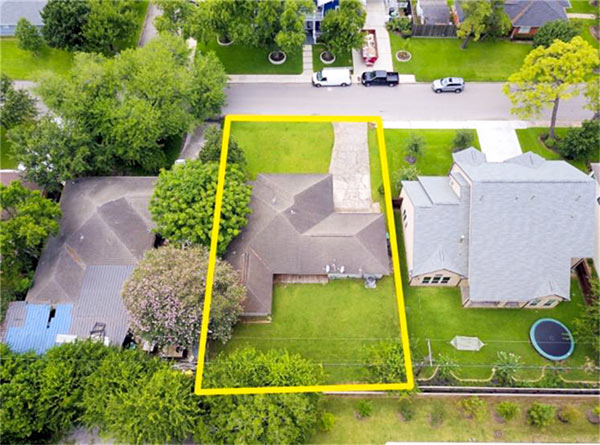 “Anything zoomed out to the neighborhood scale post-Harvey impact-wise waters down the data so much as to be useless. In the Knollwood-Woodside area where homes are “up ~3%,†it’s a mix of ~$800k newbuilds that mostly didn’t flood and ~$400-500k 1950s houses, some of which flooded and many-most that didn’t. That means any additional newbuild sale immediately skews the pricing average. What has already hit the market lately are mostly original homes that flooded, being sold as-is as teardowns (continuing the trend of the neighborhood), with lot-value on an upswing. I guess I presume all of Knollwood will be new construction in the near future, and almost all of ‘greater Braeswood’ being new construction soon, with everything getting higher elevations . . .” [juancarlos31, commenting on Harvey’s Effect on Housing Prices, Neighborhood by Neighborhood; Houston Press Stops the Presses; Astros Fans Flood Downtown] Photo of house for sale at 8311 Lorrie Dr., Knollwood Village: HAR
“Anything zoomed out to the neighborhood scale post-Harvey impact-wise waters down the data so much as to be useless. In the Knollwood-Woodside area where homes are “up ~3%,†it’s a mix of ~$800k newbuilds that mostly didn’t flood and ~$400-500k 1950s houses, some of which flooded and many-most that didn’t. That means any additional newbuild sale immediately skews the pricing average. What has already hit the market lately are mostly original homes that flooded, being sold as-is as teardowns (continuing the trend of the neighborhood), with lot-value on an upswing. I guess I presume all of Knollwood will be new construction in the near future, and almost all of ‘greater Braeswood’ being new construction soon, with everything getting higher elevations . . .” [juancarlos31, commenting on Harvey’s Effect on Housing Prices, Neighborhood by Neighborhood; Houston Press Stops the Presses; Astros Fans Flood Downtown] Photo of house for sale at 8311 Lorrie Dr., Knollwood Village: HAR
2100 MEMORIAL’S EVICTION ORDER, COMPLETELY TRANSFORMED 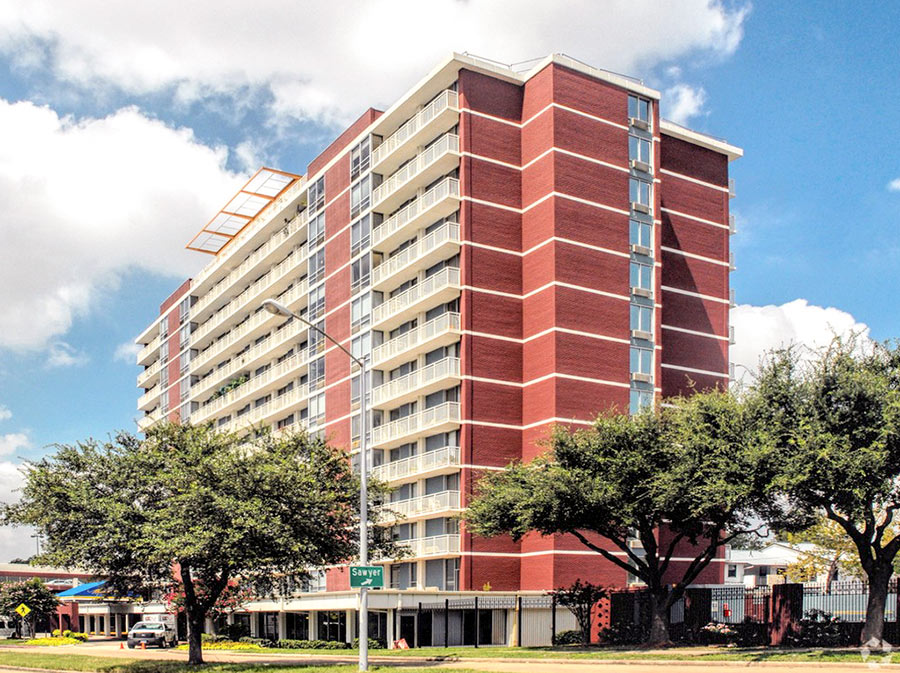 A statement from the Houston Housing Authority yesterday says it “is making every effort to comply” with a judge’s temporary restraining order issued last week ordering the public agency to fix the fire-safety systems at the 14-story 2100 Memorial senior living apartment complex, test the building’s electrical transformers, and replace them if necessary. Judge Daryl Moore also prohibited the authority from terminating the leases of any of its tenants without demonstrating better cause than it has. An estimated 80 percent of the former Holiday Inn’s residents have already moved out. [Houston Chronicle; more; previously on Swamplot]Â Photo: Realtor.com
A statement from the Houston Housing Authority yesterday says it “is making every effort to comply” with a judge’s temporary restraining order issued last week ordering the public agency to fix the fire-safety systems at the 14-story 2100 Memorial senior living apartment complex, test the building’s electrical transformers, and replace them if necessary. Judge Daryl Moore also prohibited the authority from terminating the leases of any of its tenants without demonstrating better cause than it has. An estimated 80 percent of the former Holiday Inn’s residents have already moved out. [Houston Chronicle; more; previously on Swamplot]Â Photo: Realtor.com

